Value of 50 biggest mining companies drops by $126 billion

The world’s 50 biggest miners are now worth $1.35 trillion after losing a combined $126 billion over the course of 2024 as the copper rally faded and gold stocks once again underperformed bullion.
At the end of 2024, the MINING.COM TOP 50* ranking of the world’s most valuable miners had a combined market capitalization of $1.28 trillion, down $126 billion for the year after a dismal final quarter when even gold firms succumbed to overall bearish sentiment.
The total stock market valuation of the world’s biggest mining companies declined by 9% or a combined $126.2 billion over the course of 2024.
A promising Q3, when the index touched its second highest level on record, quickly turned sour and only eight constituents made gains over the final three months of the year.
The Top 50 is now trading a stomach churning $480 billion below the peak hit in the second quarter of 2022, when the entire mining complex was riding high from uranium and nickel to copper and gold.
Much of the blame for the drift lower can be laid at the door of mining’s traditional champions.
Passing parade
Mining’s traditional big 5 – BHP, Rio Tinto, Glencore, Vale and Anglo American – that trace their roots back many decades if not more than a century, were pounded down in 2024.
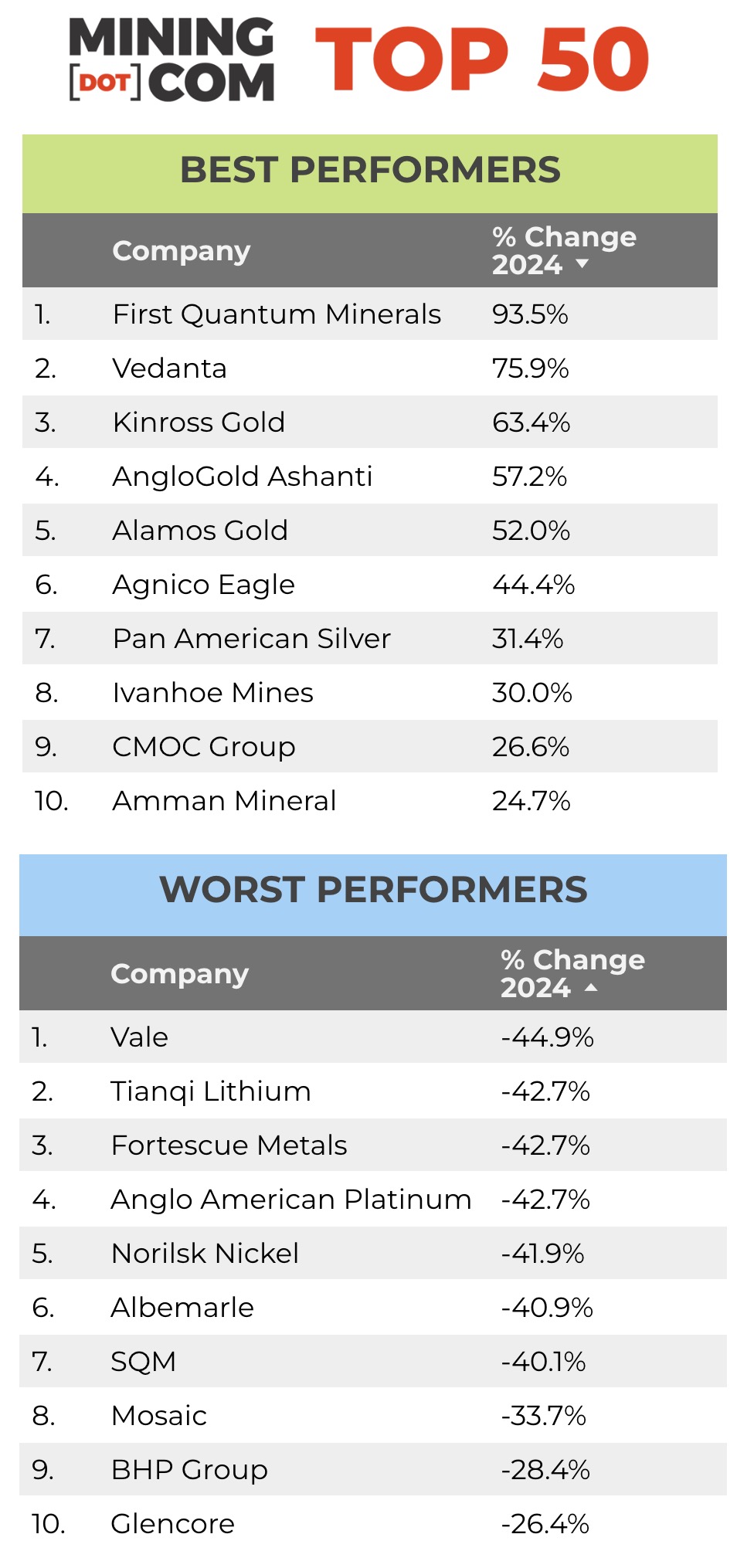
Together the stalwarts shed 25.3% or $119.7 billion of their value as their bread and butter commodities – copper and iron ore – went into retreat.
The rampant dollar over the final months of 2024 only compounded losses: MINING.COM’s Top 50 considers performance in US$ market capitalisation terms, not share price changes in local currency on domestic exchanges.
In the past these companies would, apart from wobbles as the Chinese supercycle became just a cycle, consistently occupy the top five slots in the ranking, supported by vast asset portfolios covering a range of commodities across many regions.
Now the big diversifieds stocks – the mining industry’s now erstwhile version of the Mag 7 – make up less than 28% of the total index, down from a height of 38% at the end of 2022.
Vale, down 44.9% for the year, a dismal outcome made worse by the 22% fall in the real last year, is the ranking’s worst performer of the year.
Vale topped $100 billion in value briefly in 2022. Now the Rio de Janeiro based giant’s market cap is down to $37.7 billion and the counter has dropped out of the top 10 position pushed out by Indonesian upstart Amman Mineral.
Anglo American is not a top 10 company anymore either but has the distinction of being the only one of the old guard which ended 2024 in positive territory, adding $5.5 billion, or 18.1% last year.
How much of that valuation is the lingering effects of BHP’s approach is debatable, but long term investors will still be carrying the shock of January 2016 when Anglo’s market cap fell below $5 billion after it came close to suffocating under a pile of debt.
With the exception of Glencore which trades but does not mine the steelmaking raw material, iron ore has been the cash cow for the big 5 as China’s massive infrastructure investment sucked upwards of 80% of seaborne cargoes and prices flirted with $200 a tonne.
In 2011, iron ore came with some of the fattest margins mining had ever enjoyed. With two-thirds of pre-tax profits coming from iron ore that year BHP recorded a $24 billion windfall, Vale reaped $23 billion, Rio racked up $15 billion and Anglo made $11 billion.
Today iron ore is back to double digits and a looming supply surge coupled with the prolonged construction malaise in China, offer little hope of a return to the go-go days.
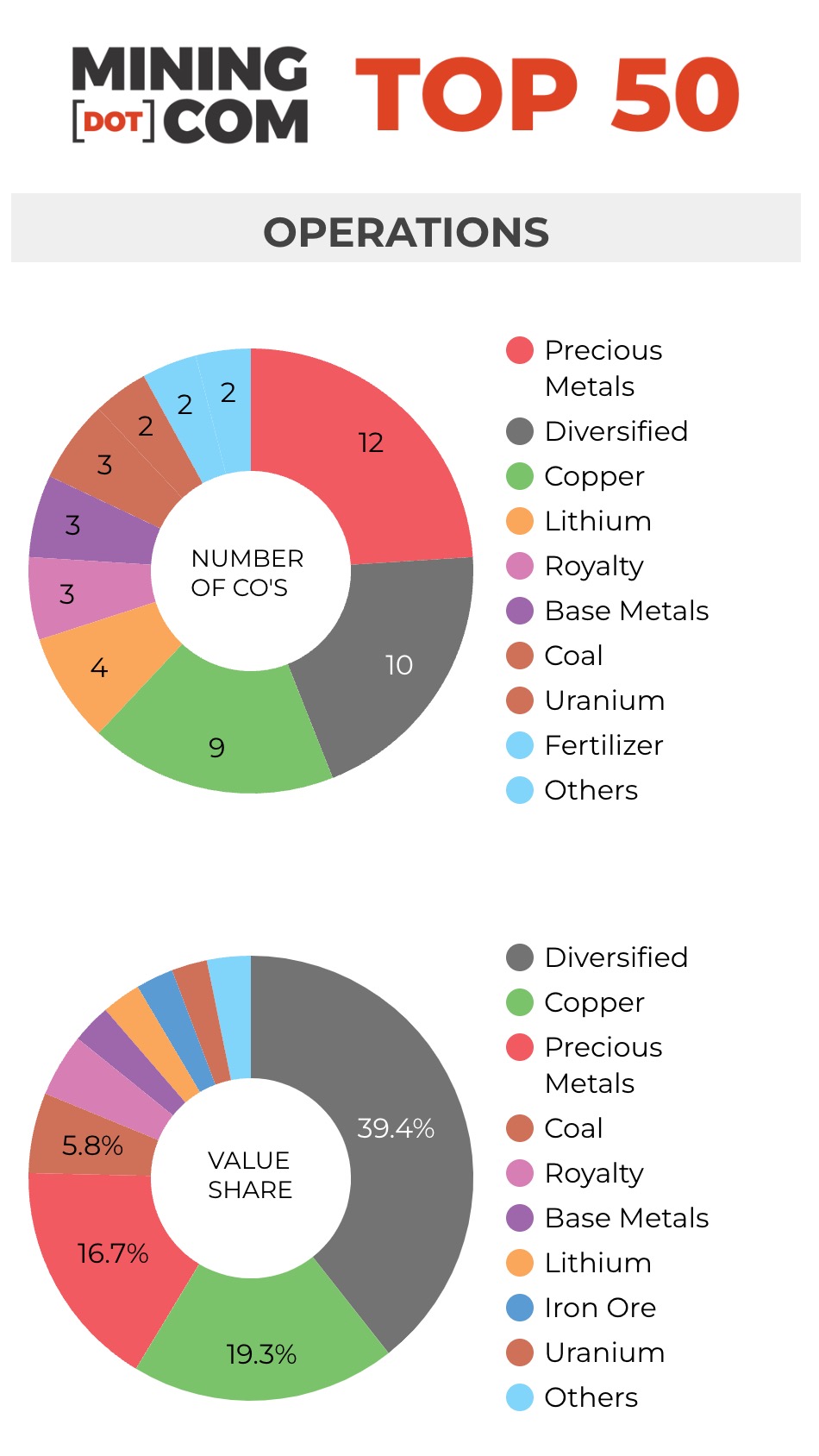
Copper cop out
Copper was going to play the role of iron ore for the Top 5 going forward and in the first half of 2024 that notion began to seem plausible.
Comex copper hit an all-time intraday high of nearly $5.20 a pound or $11,500 per tonne. In one 24-hour period trading volumes scaled $100 billion (twice the Dow daily average) with the bellwether metal attracting investors well beyond mining.
Amid the frenzy, forecasts became ever more outlandish with 50% upside from the all-time high actually one of the more sober predictions. But it didn’t take long for the squeeze to be squoze and by the end of the year copper had barely eked out a gain. Turns out copper is not the new oil.
With the copper-heavy Anglo deal dead in the water, a pivot to organic growth is under way at BHP with up to $10bn being spent on Escondida alone, the world’s largest copper mine.
Rio Tinto benefits from the fact that BHP has been working its Melbourne neighbour’s 30% stake in Escondida so hard while its Resolution copper project in Arizona languishes in permitting hell.
The long-running battle to expand Oyu Tolgoi in Mongolia also seems to have reached a steady state, but Rio’s diversification bent and penchant for opportunistic investment are intact.
The company, one of only two miners with a $100 billion-plus valuation (and only just) spent $6.7 billion to buy into lithium in 2024 just as its Jadar project in Serbia was thrown a lifeline. Whether the project goes into production is still in dispute, much like the prospects for lithium.
Glencore finally got a piece of Teck Resources last year, but while highly profitable at the moment, coal is not exactly the future of mining.
With geopolitics and global trade entering ever more dangerous territory, Glencore may find its trading business beginning to throw off cash. The Swiss company, which has for decades been negotiating commodity trading waters few are willing to wade into may also want to avoid the Las Bambas effect.
The prospects of an IPO for Vale’s base metals spin-off seems to be vanishing into the distance and is now scheduled “going into 2027”. Moreover, the $25 billion to $30 billion promised spending to build up the business seems lavish with copper and nickel’s medium term prospects less than inspiring.
The other 5
Southern Copper, part of conglomerate Grupo Mexico, seems unlikely to be toppled from the third spot any time soon while fellow copper specialist Freeport-McMoRan edged Glencore out of the top 5.
One out of only five listed companies with a copper production target for 2024 above one million tonnes, fourth-placed Zijin’s management seems to hold to the belief that in a boom and bust industry diversity is still the key to success.
The rapidly growing company’s latest acquisition target is another billion dollar lithium miner, the $6.4 billion market cap Shenzhen-listed Zannge. The Zannge approach follows the rather controversial takeover of the giant Manono lithium project in the DRC which Australia’s AVZ Minerals claim was unlawful.
Lithium stocks made the worst performing list their own during 2024 and the ranks of the battery metal producers have thinned. Already a crowded space, and with deep-pocketed Big Oil taking an active interest, most notably the new Ma’aden and Aramco deal, lithium will be tightly contested in the years ahead. Surging demand notwithstanding.
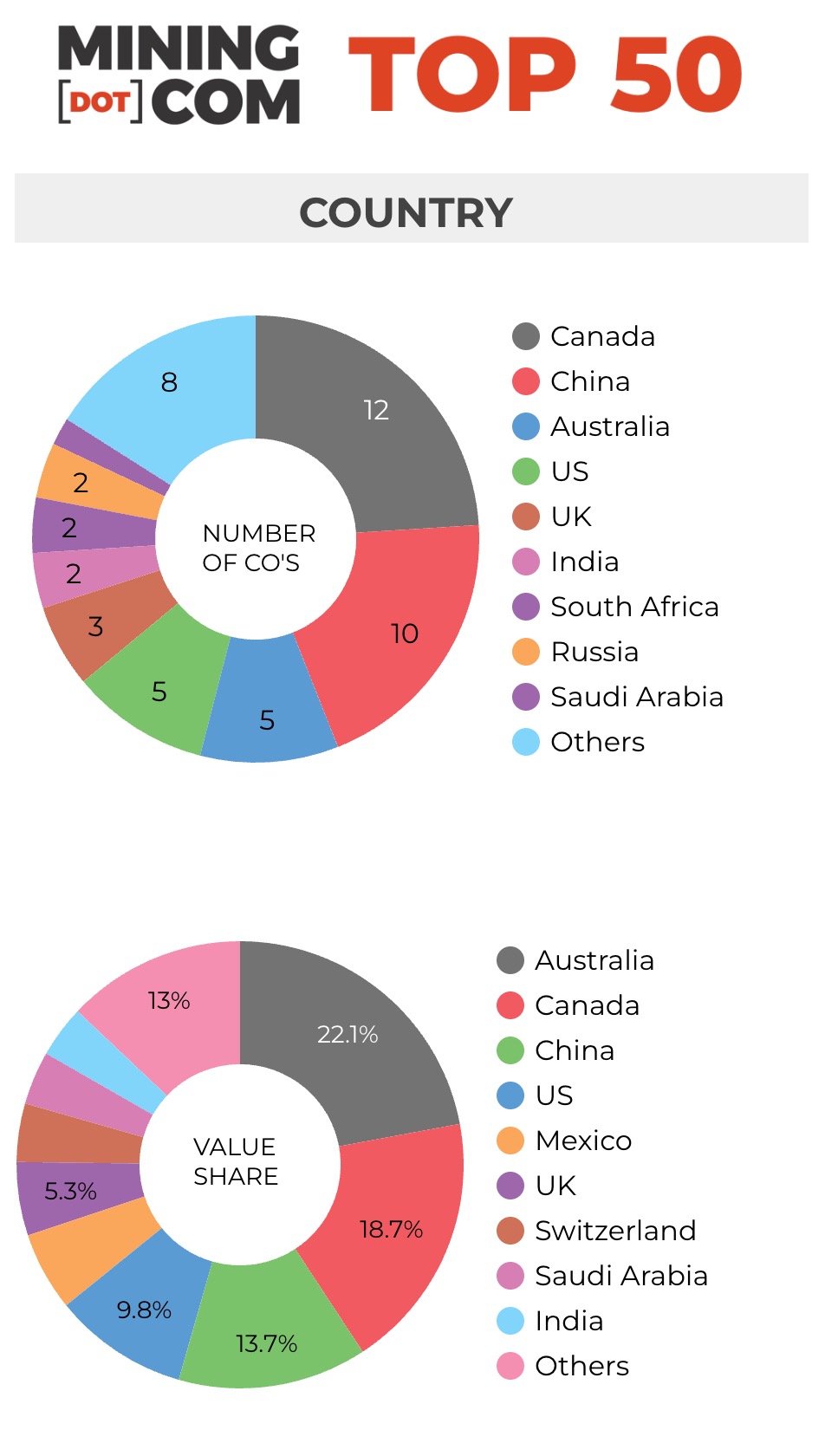
Amman Mineral continues its run up, piercing the top 10 for the first time after gaining 24.7% in 2024, and 360% since its debut in Jakarta in early 2023. Some froth has disappeared from the copper-gold company’s valuation as losses from its peak at the end of Q2 last year now top $13 billion.
While First Quantum Minerals ended up the clear leader among the best performers as the prospects of the re-opening of Cobre Panama mine become brighter, Polish copper major KGHM leaving the Top 50 in Q4 puts a cap on a what-could-have-been year for copper stocks.
Not that shiny
The value of precious metals and royalty companies climbed by a modest $18.4 billion or 7.2% in 2024, compared to gold’s 27% run up and silver’s 22% charge.
Gold stocks’ relative weakness against the gold price is a perennial problem for the industry exemplified by the world’s top two producers Newmont and Barrick, which lost ground in 2024.
Apart from missed targets and rising production costs at both firms, Barrick is also dealing with severe problems in Mali where it is halting its Loulo-Gounkoto mine in a dispute with the West African country’s military rulers.
While Barrick moves into copper (upper guidance for 2024 is 210kt) and Newmont trims its portfolio, Agnico Eagle continues to pick up assets large and small.
On a dollar basis Agnico is the best performing stock in the Top 50, adding $12.6 billion in value in 2024 (versus $9.3 billion for Zijin and $8.8 billion for India’s Vedanta) and enters the top 10 for the first time.
Were it not for the limited tradability of stock in Russia’s Polyus, which greatly underperformed its peers on an ounce for ounce basis (the Moscow-based company’s 2024 target is 2.8moz) the sector’s standing in the ranks would also be greater.
The position and annual performance of South Africa’s Goldfields were also hurt by exaggerated moves in its stock and the South African rand on the day the snapshot was taken. The Johannesburg-based company is off to the races in the opening weeks of 2024, jumping by 14% for a $13.3 billion valuation.
Alamos Gold joined the top 50 for the first time in Q3 last year and with a more than 50% jump in value in 2024 now appears firmly ensconced in the top 50 with a valuation of $8.1 billion at the end of the quarter.
The second quarter’s newcomer Pan American Silver (following its absorption of Yamana Gold) is also likely to be a permanent fixture.
Uzbekistan is readying an IPO for Navoi Mining and Metallurgy Combinat – the world’s fourth largest gold mining company and significant uranium producer in 2025. NMMC debuted a $1 billion bond offering in September, marking the first global debt market issuance from a gold mining company since June 2023.
Navoi should easily join the ranks of gold producers in the top 50 thanks to ownership of the world’s largest gold mine, Muruntau, and annual production of 2.9 million ounces at grades and per ounce extraction costs the envy of the sector.
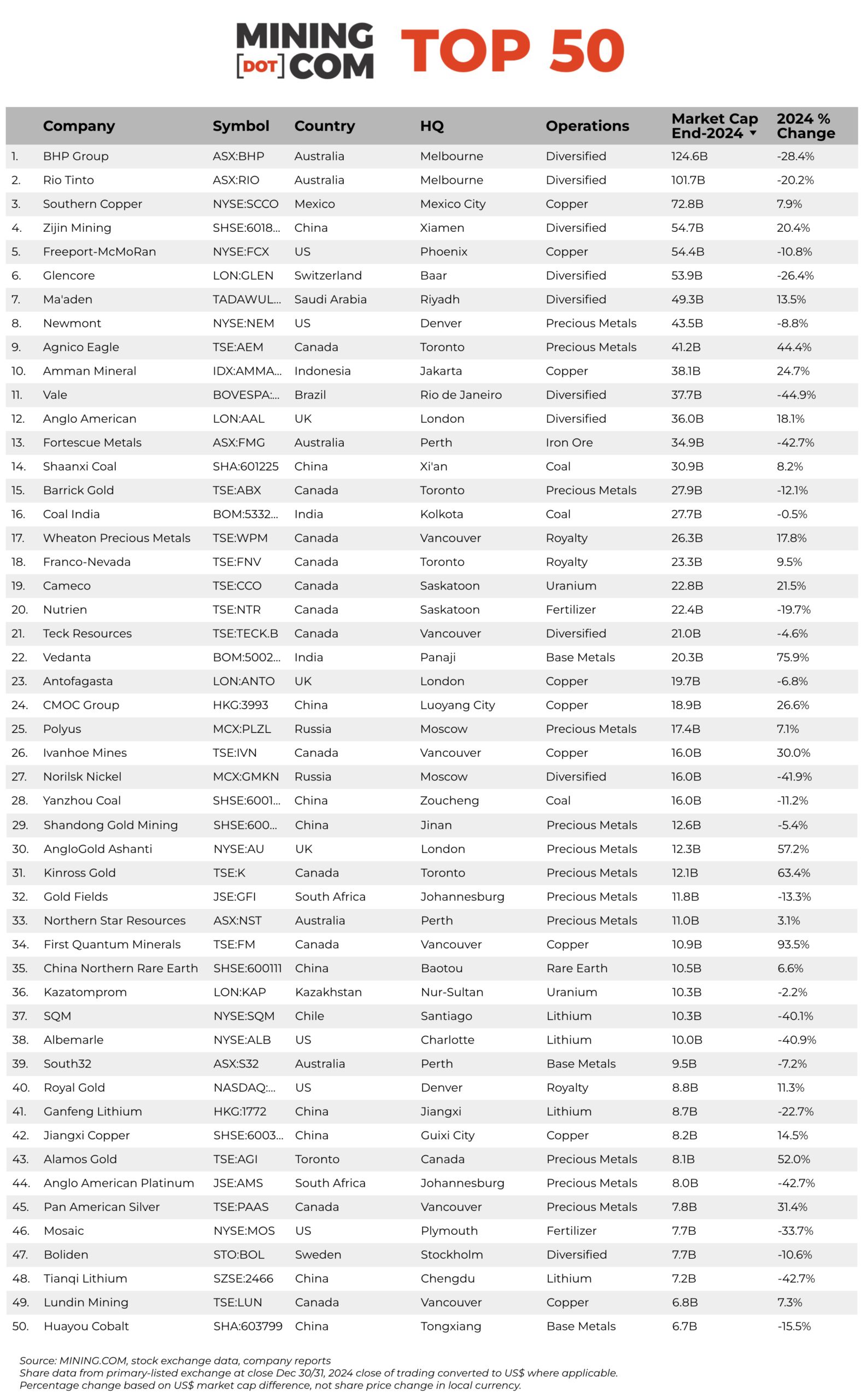
NOTES:
Source: MINING.COM, stock exchange data, company reports. Share data from primary-listed exchange at close Dec 30/31, 2024 close of trading converted to US$ where applicable. Percentage change based on US$ market cap difference, not share price change in local currency.
As with any ranking, criteria for inclusion are contentious. We decided to exclude unlisted and state-owned enterprises at the outset due to a lack of information. That, of course, excludes giants like Chile’s Codelco, Uzbekistan’s Navoi Mining (the gold and uranium giant may list later this year), Eurochem, a major potash firm, and a number of entities in China and developing countries around the world.
Another central criterion was the depth of involvement in the industry before an enterprise can rightfully be called a mining company.
For instance, should smelter companies or commodity traders that own minority stakes in mining assets be included, especially if these investments have no operational component or warrant a seat on the board?
This is a common structure in Asia and excluding these types of companies removed well-known names like Japan’s Marubeni and Mitsui, Korea Zinc and Chile’s Copec.
Levels of operational or strategic involvement and size of shareholding were other central considerations. Do streaming and royalty companies that receive metals from mining operations without shareholding qualify or are they just specialised financing vehicles? We included Franco Nevada, Royal Gold and Wheaton Precious Metals on the basis of their deep involvement in the industry.
Vertically integrated concerns like Alcoa and energy companies such as Shenhua Energy or Bayan Resources where power, ports and railways make up a large portion of revenues pose a problem. The revenue mix also tends to change alongside volatile coal prices. Same goes for battery makers like China’s CATL which is increasingly moving upstream, but where mining will continue to represent a small portion of its valuation.
Another consideration is diversified companies such as Anglo American with separately listed majority-owned subsidiaries. We’ve included Angloplat in the ranking but excluded Kumba Iron Ore in which Anglo has a 70% stake to avoid double counting. Similarly we excluded Hindustan Zinc which is listed separately but majority owned by Vedanta.
Many steelmakers own and often operate iron ore and other metal mines, but in the interest of balance and diversity we excluded the steel industry, and with that many companies that have substantial mining assets including giants like ArcelorMittal, Magnitogorsk, Ternium, Baosteel and many others.
Head office refers to operational headquarters wherever applicable, for example BHP and Rio Tinto are shown as Melbourne, Australia, but Antofagasta is the exception that proves the rule. We consider the company’s HQ to be in London, where it has been listed since the late 1800s.
Please let us know of any errors, omissions, deletions or additions to the ranking or suggest a different methodology.
{{ commodity.name }}
{{ post.title }}
{{ post.date }}
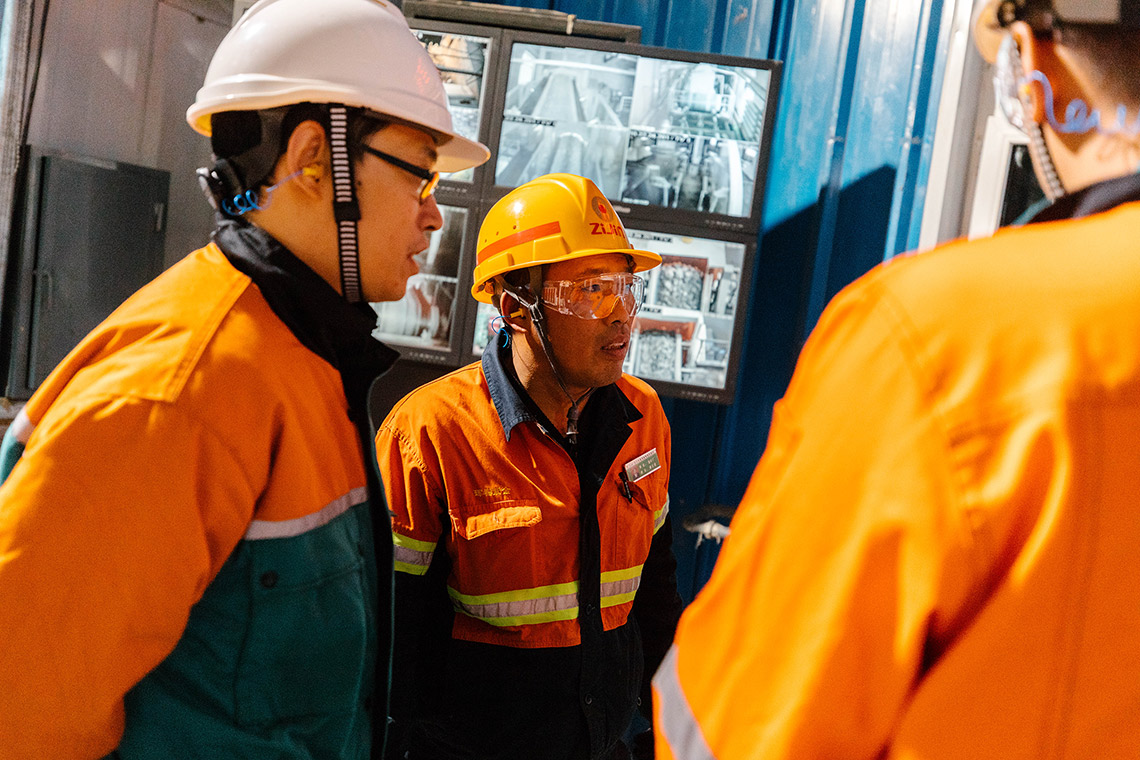
Comments
Christina Dian Parmionova
Selling mining stocks.